1999 HONDA CIVIC COUPE instrument panel
[x] Cancel search: instrument panelPage 1 of 269

1999 Civic Coupe Online Reference Owner's Manual
Use these links (and links throughout this manual) to navigate through this reference.
For a printed owner's manual, click on authorized manuals or go to www.helminc.com.
Contents
Introduction........................................................................\
............................................................................. i
A Few Words About Safety ........................................................................\
.................................................. ii
Your Vehicle at a Glance ........................................................................\
....................................................... 2
Driver and Passenger Safety ........................................................................\
............................................... 5
Pr op
er use and care of your vehicle's seat belts, and Supplemental Restraint System.
Instruments and Controls........................................................................\
...................................................51
Instrument panel in
dicator and gauge, and how to use dashboard and steering column controls.
Comfort and Convenience Features........................................................................\
.................................87
How to op
erate the climate control system, the audio system, and other convenience features.
Before Driving ........................................................................\
.....................................................................123
What gasoli n
e to u
se, how to break-in your new vehicle, and how to load luggage and other cargo.
Driving........................................................................\
...................................................................................135
The proper way t o
start the engine, shift the tr ansmission, and park, plus towing a trailer.
Maintenance........................................................................\
.........................................................................157
T h
e Ma
intenance Schedule shows you when you need to take your vehicle to the dealer.
Appearance Care........................................................................\
.................................................................213
T i
ps on cl
eaning and protecting your vehicle. Things to look for if your car ever needs body repairs.
Taking Care of the Unexpected........................................................................\
.......................................219
This section covers sever
a
l problems motorists someti mes experience, and how to handle them.
Technical Information........................................................................\
.......................................................243
ID numbers, dimens ions, capacities, and techn
ical information.
Warranty and Customer Relations (U.S. and Canada)......................................................................257
A summary of th
e warr
anties covering your new Honda, and how to contact us.
Authorized Manuals (U.S. only)........................................................................\
.......................................263
How t o
order
manuals and other technical literature.
Index ........................................................................\
......................................................................................... I
Servic e Inf
ormation Summary
A summary of informa
tion you need when you pull up to the fuel pump.
Owner's Identification
Page 5 of 269
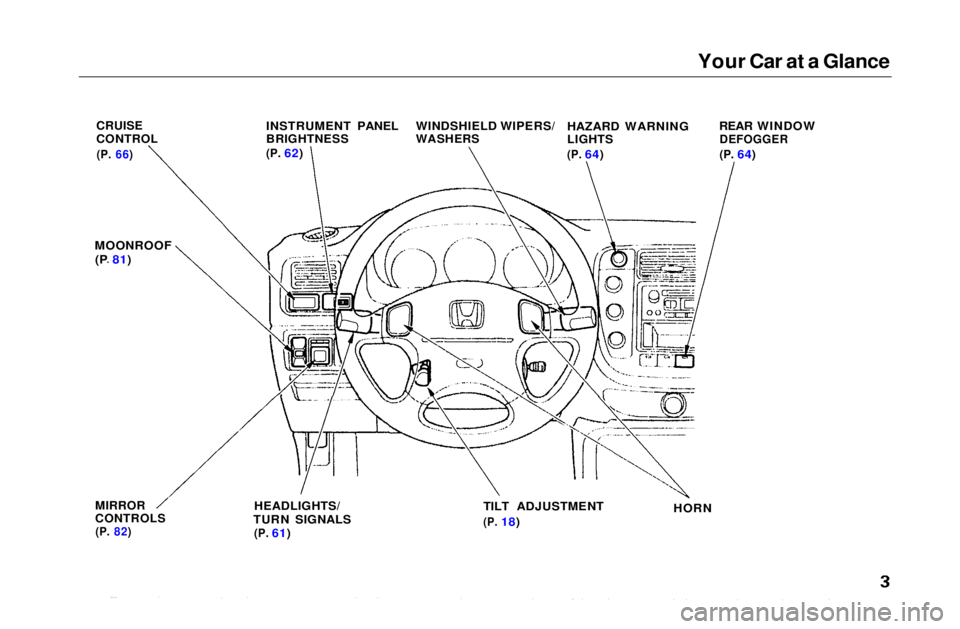
Your Car at a Glance
CRUISE
CONTROL
(P.
66)
INSTRUMENT PANEL
BRIGHTNESS
(P.
62)
WINDSHIELD WIPERS/
WASHERS
HAZARD WARNING
LIGHTS
(P.
64) REAR WINDOW
DEFOGGER
(P.
64)
MOONROOF (P 81)
MIRROR
CONTROLS
(P.
82)
HEADLIGHTS/
TURN SIGNALS
(P.
61) TILT ADJUSTMENT
(P.
18)
HORNMain Menu s t
Page 9 of 269
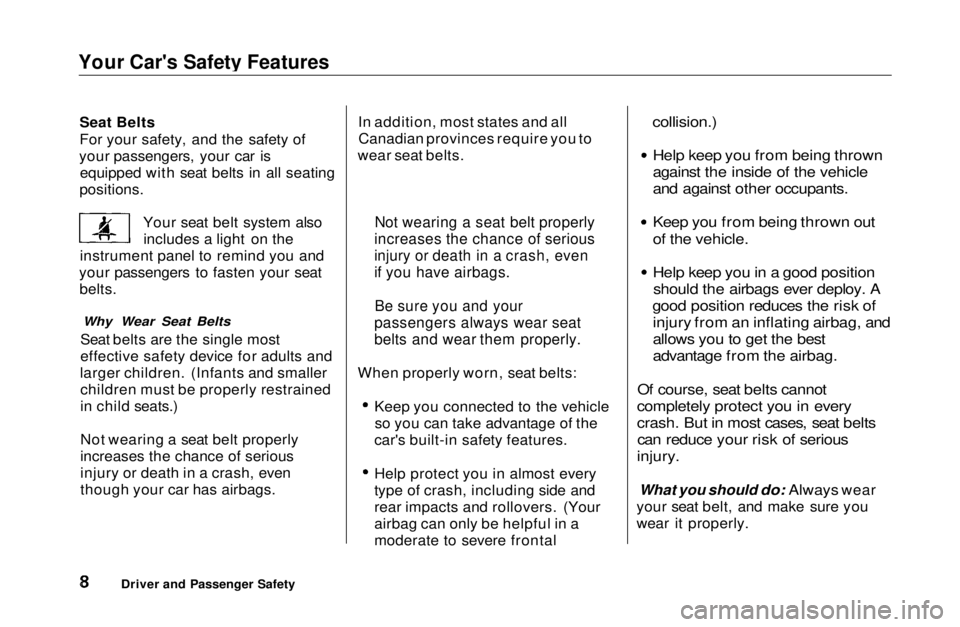
Your Car's Safety Features
Seat Belts
For your safety, and the safety of
your passengers, your car is equipped with seat belts in all seating
positions.
Your seat belt system alsoincludes a light on the
instrument panel to remind you and
your passengers to fasten your seat belts.
Why Wear Seat Belts
Seat belts are the single most
effective safety device for adults and
larger children. (Infants and smaller children must be properly restrained
in child seats.)
Not wearing a seat belt properly
increases the chance of serious
injury or death in a crash, even
though your car has airbags. In addition, most states and all
Canadian provinces require you to
wear seat belts.
When properly worn, seat belts:
Keep you connected to the vehicleso you can take advantage of the
car's built-in safety features. Help protect you in almost every
type of crash, including side and
rear impacts and rollovers. (Your
airbag can only be helpful in a
moderate to severe frontal
collision.)
Help keep you from being thrown
against the inside of the vehicle
and against other occupants.
Keep you from being thrown out
of the vehicle. Help keep you in a good position
should the airbags ever deploy. A
good position reduces the risk of injury from an inflating airbag, and
allows you to get the best
advantage from the airbag.
Of course, seat belts cannot
completely protect you in every
crash. But in most cases, seat belts can reduce your risk of serious
injury.
What you should do: Always wear
your sea t
belt, and make sure you
wear it properly.
Driver and Passenger Safety
Not wearing a seat belt properly
increases the chance of serious
injury or death in a crash, even
if you have airbags.
Be sure you and your
passengers always wear seat
belts and wear them properly.Main Menu Table of Contents s t
Page 10 of 269
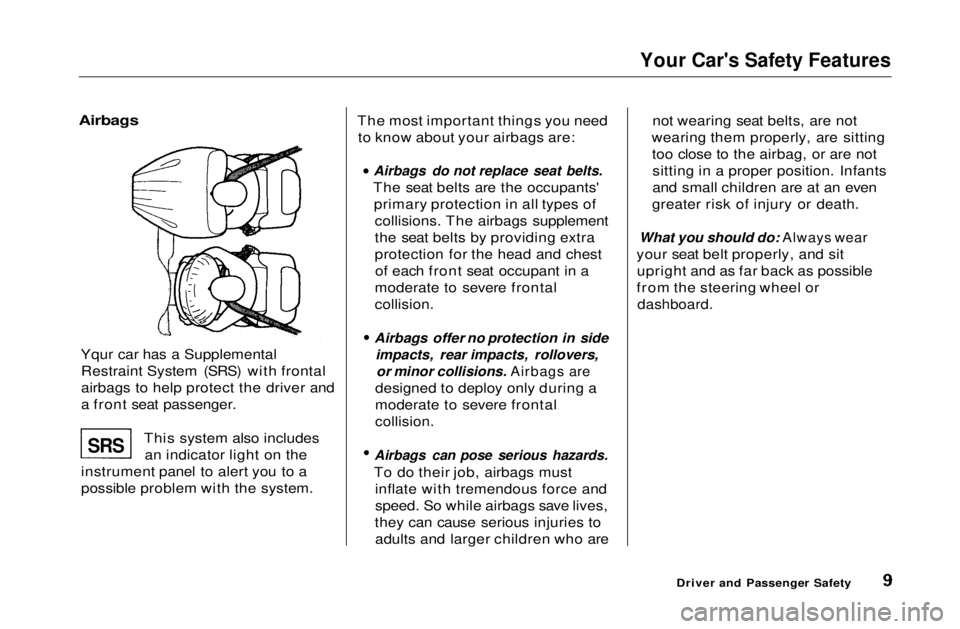
Your Car's Safety Features
Airbags
Yqur car has a SupplementalRestraint System (SRS) with frontal
airbags to help protect the driver and
a front seat passenger.
This system also includesan indicator light on the
instrument panel to alert you to a
possible problem with the system. The most important things you need
to know about your airbags are:
Airbags do not replace seat belts.
The seat belts are the occupants' primary protection in all types ofcollisions. The airbags supplement
the seat belts by providing extra
protection for the head and chestof each front seat occupant in a
moderate to severe frontal
collision.
Airbags offer no protection in side
impacts, rear impacts, rollovers,
or minor collisions. Airbags are
designed to deploy only during a
moderate to severe frontal
collision.
Airbags can pose serious hazards.
To do their job, airbags must inflate with tremendous force and
speed. So while airbags save lives,
they can cause serious injuries to adults and larger children who are not wearing seat belts, are not
wearing them properly, are sitting too close to the airbag, or are notsitting in a proper position. Infants
and small children are at an even
greater risk of injury or death.
What you should do: Always wear
your seat belt properly, and sit upright and as far back as possible
from the steering wheel or
dashboard.
Driver and Passenger Safety
SRSMain Menu Table of Contents s t
Page 13 of 269
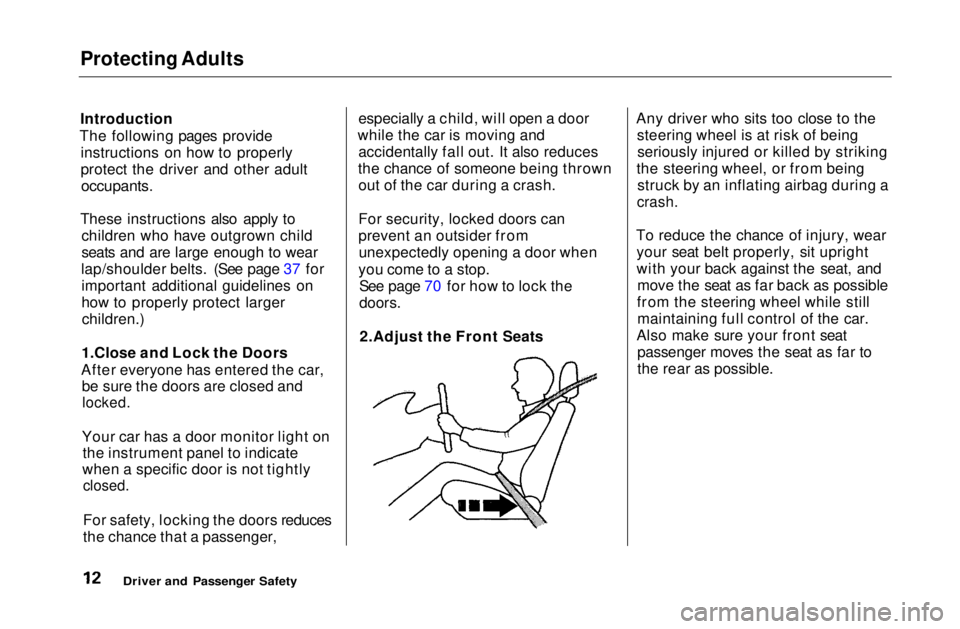
Protecting Adults
Introduction
The following pages provide instructions on how to properly
protect the driver and other adult
occupants.
These instructions also apply to children who have outgrown child
seats and are large enough to wear
lap/shoulder belts. (See page 37 for important additional guidelines on
how to properly protect largerchildren.)
1.Close and Lock the Doors
After everyone has entered the car, be sure the doors are closed and
locked.
Your car has a door monitor light on the instrument panel to indicate
when a specific door is not tightly
closed.
For safety, locking the doors reduces
the chance that a passenger, especially a child, will open a door
while the car is moving and accidentally fall out. It also reduces
the chance of someone being thrown out of the car during a crash.
For security, locked doors can
prevent an outsider fromunexpectedly opening a door when
you come to a stop. See page 70 for how to lock the
doors.
2.Adjust the Front Seats Any driver who sits too close to the
steering wheel is at risk of beingseriously injured or killed by striking
the steering wheel, or from being struck by an inflating airbag during a
crash.
To reduce the chance of injury, wear your seat belt properly, sit upright
with your back against the seat, and move the seat as far back as possible
from the steering wheel while still maintaining full control of the car.
Also make sure your front seat passenger moves the seat as far to
the rear as possible.
Driver and Passenger SafetyMain Menu Table of Contents s t
Page 43 of 269
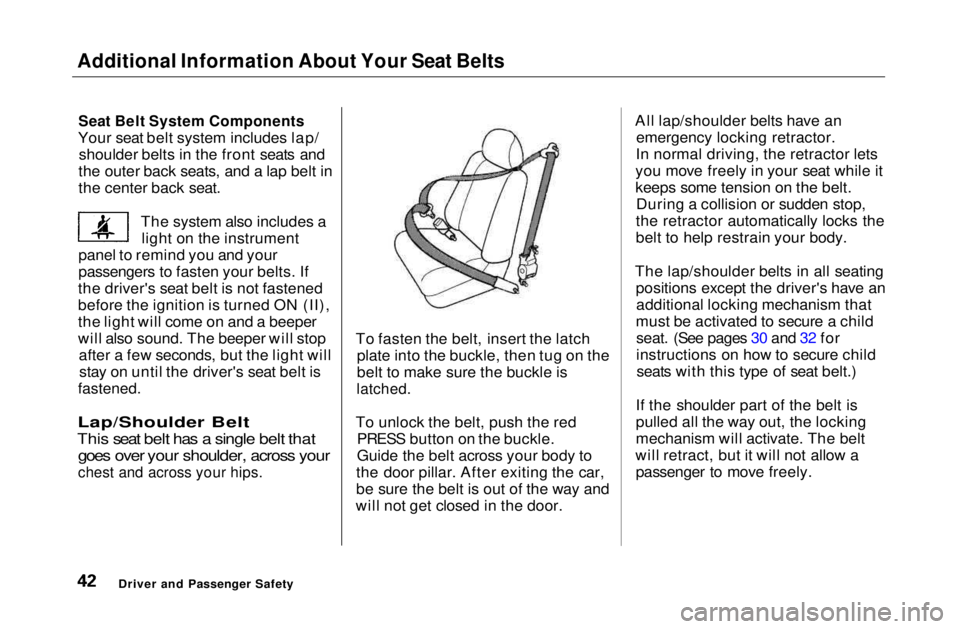
Additional Information About Your Seat Belts
Seat Belt System Components
Your seat belt system includes lap/ shoulder belts in the front seats and
the outer back seats, and a lap belt in
the center back seat.
The system also includes alight on the instrument
panel to remind you and your
passengers to fasten your belts. If
the driver's seat belt is not fastened
before the ignition is turned ON (II),
the light will come on and a beeper
will also sound. The beeper will stop after a few seconds, but the light willstay on until the driver's seat belt is
fastened.
Lap/Shoulder Belt
This sea t
belt has a single belt that
goes over your shoulder, across your
chest and across your hips.
To fasten the belt, insert the latch
plate into the buckle, then tug on the
belt to make sure the buckle is
latched.
To unlock the belt, push the red PRESS button on the buckle.
Guide the belt across your body to
the door pillar. After exiting the car,
be sure the belt is out of the way and
will not get closed in the door. All lap/shoulder belts have an
emergency locking retractor.
In normal driving, the retractor lets
you move freely in your seat while it
keeps some tension on the belt. During a collision or sudden stop,
the retractor automatically locks the
belt to help restrain your body.
The lap/shoulder belts in all seating positions except the driver's have anadditional locking mechanism that
must be activated to secure a child seat. (See pages 30 and 32 for
instructions on how to secure childseats with this type of seat belt.)
If the shoulder part of the belt is
pulled all the way out, the locking
mechanism will activate. The belt
will retract, but it will not allow a passenger to move freely.
Driver and Passenger SafetyMain Menu Table of Contents s t
Page 46 of 269

Additional Information About Your SRS
SRS Components
Your Supplemental Restraint System (SRS) includes: Two front airbags. The driver's
airbag is stored in the center of
the steering wheel; the front
passenger's airbag is stored in the dashboard. Both are marked "SRS
AIRBAG." Sensors that can detect a
moderate to severe frontal
collision. A sophisticated electronic system
that continually monitors thesensors, control unit, the airbag
activators, and all related wiring
when the ignition is ON (II). An indicator light on the
instrument panel that alerts you to
a possible problem with thesystem (see page 47). Emergency backup power in case
your car's electrical system is disconnected in a crash. How Your Airbags Work
If you ever have a moderate tosevere frontal collision, the sensors
will detect rapid deceleration and signal the control unit to instantly
inflate the airbags.
During a crash, your seat belt helps
restrain your lower body and torso.
Your airbag provides a cushion to help restrain and protect your headand chest.
Driver and Passenger Safety
CONTINUEDMain Menu Table of Contents s t
Page 52 of 269

Instruments and Controls
This section gives information about
the controls and displays thatcontribute to the daily operation of
your Honda. All the essential
controls are within easy reach.
Control Locations............................ 52
Indicator Lights................................ 53
Gauges.............................................. 57
Speedometer................................ 57
Tachometer.................................. 57
Odometer...................................... 57
Trip Meter.................................... 57
Fuel Gauge................................... 58
Temperature Gauge.................... 58
Maintenance Required
Indicator.................................... 59
Controls Near the Steering Wheel........................................ 60
Headlights.................................... 61
Daytime Running Lights............. 61
Instrument Panel Brightness..... 62
Turn Signals................................. 62
Windshield Wipers...................... 63
Windshield Washers................... 63
Hazard Warning........................... 64
Rear Window Defogger.............. 64
Steering Wheel Adjustment....... 65
Steering Wheel Controls ................ 66 Cruise Control.............................. 66
Keys and Locks................................ 69
Keys.............................................. 69
Ignition Switch............................. 69
Door Locks................................... 70
Power Door Locks....................... 71
Remote Transmitter.................... 72
Trunk............................................ 75
Seat Adjustments............................. 76
Front Seat Adjustments.............. 76
Rear Seat Access......................... 77
Head Restraints........................... 77
Folding Rear Seat............................ 78
Power Windows............................... 79
Moonroof.......................................... 81
Mirrors.............................................. 81
Adjusting the Power Mirrors..... 82
Parking Brake.................................. 83 Glove Box......................................... 83
Beverage Holder.............................. 84
Accessory Power Socket................ 85
Ashtrays............................................ 85
Interior Light.................................... 86
Instruments and ControlsMain Menu s t